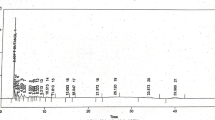Abstract
Olive fruit is very rich in terms of phenolic compounds. Antimicrobial activities of various phenolic compounds against bacteria and fungi are well established; however, their effects on yeasts have not been examined. Aim of this study was to investigate the antimicrobial effects induced by olive phenolic compounds, including tyrosol, hydroxytyrosol, oleuropein, luteolin and apigenin against two yeast species, Aureobasidium pullulans and Saccharomyces cerevisiae. For this purpose, yeasts were treated with various concentrations (12.5–1000 ppm) of phenolic compounds and reduction in yeast population was followed with optical density measurements with microplate reader, yeast colony forming units and mid-infrared spectroscopy. All phenolic compounds were effective on both yeasts, especially 200 ppm and higher concentrations have significant antimicrobial activity; however, effects of lower levels depend on the type of phenolic compound. According to mid-infrared spectral data, significant changes were observed in 1200–900 cm−1 range corresponding to carbohydrates of yeast structure as a result of exposure to all phenolic compounds except tyrosol. Spectra of tyrosol and luteolin treated yeasts also showed changes in 1750–1500 cm−1 related to amide section and 3600–3000 cm−1 fatty acid region. Since phenolic compounds from olives were effective against yeasts, they could be used in food applications where yeast growth showed problem. In addition, FTIR spectroscopy could be successfully used to monitor and characterize antimicrobial activity of phenolic compounds on yeasts as complementary to conventional microbiological methods.





Similar content being viewed by others
References
Aktas AB, Ozen B, Tokatli F, Sen I (2014) Comparison of some chemical parameters of a naturally debittered olive. Food Chem 161:104–111
Al-Qadiri HM, Al-Alami NI, Al-Holy MA, Rasco BA (2008a) Using Fourier transform infrared (FT-IR) absorbance spectroscopy and multivariate analysis to study the effect of chlorine-induced bacterial injury in water. J Agric Food Chem 56:8992–8997
Al-Qadiri HM, Lin M, Al-Holy MA, Cavinato AG, Rasco BA (2008b) Detection of sublethal thermal injury in Salmonella enterica serotype Typhimurium and Listeria monocytogenes using Fourier transform infrared (FT-IR) spectroscopy (4000–600 cm−1). J Food Sci 73:M54–M61
Alvarez-Ordonez A, Halisch J, Prieto M (2010) Changes in Fourier transform infrared spectra of Salmonella enterica serovars Typhimurium and Enteritidis after adaptation to stressful growth conditions. Int J Food Microbiol 142:97–105
Alvarez-Ordonez A, Mouwen DJM, Lopez M, Prieto M (2011) Fourier transform infrared spectroscopy as a tool to characterize molecular composition and stress response in foodborne pathogenic bacteria. J Microbiol Meth 84:369–378
Ami D, Natalello A, Schultz T, Gatti-Lafranconi P, Lotti M, Doglia SM, De Marco A (2009) Effects of recombinant protein misfolding and aggregation on bacterial membranes. BBA Proteins Proteom 1794:263–269
Bendini A, Cerretani L, Carrasco-Pancorbo A, Gómez-Caravaca AM, Segura-Carretero A, Fernández-Gutiérrez A, Lercker G (2007) Phenolic molecules in virgin olive oils: a survey of their sensory properties, health effects, antioxidant activity and analytical methods. An overview of the last decade Alessandra. Molecules 12:1679–1719
Bisignano G, Tomaino A, Cascio RL, Crisafi G, Uccella N, Saija A (1999) On the in vitro antimicrobial activity of oleuropein and hydroxytyrosol. J Pharm Pharmacol 51:971–974
Corte L, Rellini P, Roscini L, Fatichenti F, Cardinali G (2010) Development of a novel, FTIR (Fourier transform infrared spectroscopy) based, yeast bioassay for toxicity testing and stress response study. Anal Chim Acta 659:258–265
Corte L, Tiecco M, Roscini L, Germani R, Cardinali G (2014) FTIR analysis of the metabolomic stress response induced by N-alkyltropinium bromide surfactants in the yeasts Saccharomyces cerevisiae and Candida albicans. Colloid Surface B 116:761–771
Dufour M, Simmonds RS, Bremer PJ (2003) Development of a method to quantify in vitro the synergistic activity of “natural” antimicrobials. Int J Food Microbiol 85:249–258
Jemai H, Bouaziz M, Sayadi S (2009) Phenolic composition, sugar contents and antioxidant activity of Tunisian sweet olive cultivar with regard to fruit ripening. J Agric Food Chem 57:2961–2968
Karaosmanoglu H, Soyer F, Ozen B, Tokatli F (2010) Antimicrobial and antioxidant activities of Turkish extra virgin olive oils. J Agric Food Chem 58:8238–8245
Kümmerle M, Scherer S, Seiler H (1998) Rapid and reliable identification of food-borne yeasts by Fourier-transform infrared spectroscopy. Appl Environ Microbiol 64:2207–2214
Mozaffarian D, Wu JH (2018) Flavonoids, dairy foods, and cardiovascular and metabolic health: a review of emerging biologic pathways. Circ Res 122:369–384
Ngo-Thi NA, Kirschner C, Naumann D (2003) Characterization and identification of microorganisms by FT-IR microspectrometry. J Mol Struct 661:371–380
Rice-Evans CA, Miller NJ, Paganga G (1996) Structure-antioxidant activity relationships of flavonoids and phenolic acids. Free Radical Bio Med 20:933–956
Saharan RK, Sharma SC (2011) FTIR spectroscopy and biochemical investigation of ethanol stressed yeast Pachysolen tannophilus. Vib Spectrosc 55:85–89
Schleicher E, Heßling B, Illarionova V, Bacher A, Weber S, Richter G, Gerwert K (2005) Light-induced reactions of Escherichia coli DNA photolyase monitored by Fourier transform infrared spectroscopy. FEBS J 272:1855–1866
Shahidi F, Ambigaipalan P (2015) Phenolics and polyphenolics in foods, beverages and spices: antioxidant activity and health effects—A review. J Funct Foods 18:820–897
Subramanian A, Ahn J, Balasubramaniam VM, Rodriguez-Saona L (2007) Monitoring biochemical changes in bacterial spore during thermal and pressure-assisted thermal processing using FT-IR spectroscopy. J Agric Food Chem 55:9311–9317
Xiao ZP, Peng ZY, Peng MJ, Yan WB, Ouyang YZ, Zhu HL (2011) Flavonoids health benefits and their molecular mechanism. Mini-Rev Med Chem 11:169–177
Zoumpopoulou G, Papadimitriou K, Polissiou MG, Tarantilis PA, Tsakalidou E (2010) Detection of changes in the cellular composition of Salmonella enterica serovar Typhimurium in the presence of antimicrobial compound (s) of Lactobacillus strains using Fourier transform infrared spectroscopy. Int J Food Microbiol 144:202–207
Acknowledgements
This study was financially supported by Izmir Institute of Technology Scientific Research Projects (IYTE SRP) Programme (Project No: 2014-IYTE-4 and 2015-IYTE-14).
Author information
Authors and Affiliations
Corresponding author
Electronic supplementary material
Below is the link to the electronic supplementary material.
Rights and permissions
About this article
Cite this article
Canal, C., Ozen, B. & Baysal, A.H. Characterization of antimicrobial activities of olive phenolics on yeasts using conventional methods and mid-infrared spectroscopy. J Food Sci Technol 56, 149–158 (2019). https://doi.org/10.1007/s13197-018-3468-4
Revised:
Accepted:
Published:
Issue Date:
DOI: https://doi.org/10.1007/s13197-018-3468-4




